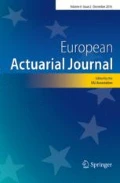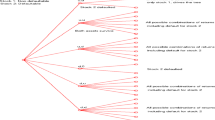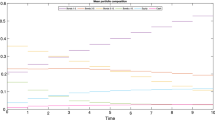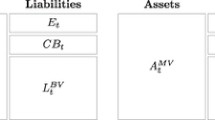Abstract
The aim of this paper is to introduce a synthetic ALM model that catches the key features of life insurance contracts. First, it keeps track of both market and book values to apply the regulatory profit sharing rule. Second, it introduces a determination of the crediting rate to policyholders that is close to practice and is a trade-off between the regulatory rate, a competitor rate and the available profits. Third, it considers an investment in bonds that enables to match a part of the cash outflow due to surrenders, while avoiding to store the trading history. We use this model to evaluate the Solvency Capital Requirement (SCR) with the standard formula, and show that the choice of the interest rate model is important to get a meaningful model after the regulatory shocks on the interest rate. We discuss the different values of the SCR modules first in a framework with moderate interest rates using the shocks of the present legislation, and then we consider a low interest framework with the latest recommendation of the EIOPA on the shocks. In both cases, we illustrate the importance of matching cash-flows and its impact on the SCR.














Similar content being viewed by others
Notes
Besides, a minimal increase (resp. decrease) of \(1\%\) is assumed for \(R^{up}(0,t)\) (resp. \(R^{down}(0,t)\)), see also Boonen [6], p. 411.
References
Albrecher H, Bauer D, Embrechts P, Filipović D, Koch-Medina P, Korn R, Loisel S, Pelsser A, Schiller F, Schmeiser H, Wagner J (2018) Asset-liability management for long-term insurance business. Eur Actuar J 8(1):9–25
Asadi S, Al Janabi Mazin AM (2020) Measuring market and credit risk under Solvency II: evaluation of the standard technique versus internal models for stock and bond markets. Eur Actuar J
Bacinello AR (2001) Fair pricing of life insurance participating policies with a minimum interest rate guaranteed. ASTIN Bull 31(2):275–297
Berdin E, Gründl H (2015) The effects of a low interest rate environment on life insurers. Geneva Papers Risk Insurance Issues Practice 40(3):385–415
Berdin E, Kok C, Pancaro C (2016) A stochastic forward-looking model to assess the profitability and solvency of European insurers. ICIR Working Paper Series 21/16, Goethe University Frankfurt, International Center for Insurance Regulation (ICIR)
Boonen TJ (2017) Solvency II solvency capital requirement for life insurance companies based on expected shortfall. Eur Actuar J 7(2):405–434
Borel-Mathurin F, Darpeix P-E, Guibert Q, Loisel S (2018) Main determinants of profit-sharing policy in the French Life Insurance Industry. Geneva Papers Risk Insurance Issues Practice 43(3):420–455
Braun A, Schmeiser H, Schreiber F (2015) Solvency II’s market risk standard formula: How credible is the proclaimed ruin probability? Journal of Insurance Issues 38(1):1–30
Briys E, de Varenne F (1997) On the risk of insurance liabilities: debunking some common pitfalls. J Risk Insurance 64(4):673–694
Damiano B, Mercurio F (2006) Interest rate models-theory and practice: with smile, inflation and credit. Springer finance, 2nd edn. Springer-Verlag, Berlin
Delong L, Dhaene J, Barigou K (2019) Fair valuation of insurance liability cash-flow streams in continuous time: applications. ASTIN Bull 49(2):299–333
EIOPA (European Insurance and Occupational Pensions Authority) (2012) Revised technical specifications for the solvency II valuation and solvency capital requirements calculations (part i). EIOPA-DOC-12/467
EIOPA (European Insurance and Occupational Pensions Authority) (2018) Eiopa’s second set of advice to the european commission on specific items in the solvency II delegated regulation. EIOPA-BoS-18/075
European Commission (2015) Delegated Regulation (EU) 2015/35. Official Journal of the European Union
Floryszczak A, Courtois OL, Majri M (2016) Inside the solvency 2 black box: net asset values and solvency capital requirements with a least-squares monte-carlo approach. Insurance 71:15–26
Gatzert N, Martin M (2012) Quantifying credit and market risk under solvency II: standard approach versus internal model. Insurance 51(3):649–666
Gerstner T, Griebel M, Holtz M, Goschnick R, Haep M (2008) A general asset-liability management model for the efficient simulation of portfolios of life insurance policies. Insurance 42(2):704–716
Grosen A, Jorgensen PL (2000) Fair valuation of life insurance liabilities: the impact of interest rate guarantees, surrender options, and bonus policies. Insurance 26(1):37–57
Kubitza C, Berdin E, Gründl H (2019) Rising interest rates and liquidity risk in the life insurance sector. ICIR Working Paper Series 29/17
Merton RC (1971) Optimum consumption and portfolio rules in a continuous-time model. J Econ Theory 3(4):373–413
Pericoli M (2018) Macroeconomics determinants of the correlation between stocks and bonds. Temi di discussione, Banca d’Italia 1198
Rankin E, Idil MS (2014) A century of stock-bond correlations. Reserve bank of Australia bulletin, September Quarter
Vedani J, El Karoui N, Loisel S, Prigent J-L (2017) Market inconsistencies of market-consistent european life insurance economic valuations: pitfalls and practical solutions. Eur Actuar J 7(1):1–28
Acknowledgements
This research benefited from the Joint Research Initiative “Numerical methods for the ALM” of AXA Research Fund. A. A. has also benefited from the support of the “Chaire Risques Financiers”, Fondation du Risque. We thank Vincent Jarlaud and the team ALM of AXA France for useful discussions and remarks.
Author information
Authors and Affiliations
Corresponding author
Additional information
Publisher's Note
Springer Nature remains neutral with regard to jurisdictional claims in published maps and institutional affiliations.
Rights and permissions
About this article
Cite this article
Alfonsi, A., Cherchali, A. & Infante Acevedo, J.A. A synthetic model for asset-liability management in life insurance, and analysis of the SCR with the standard formula. Eur. Actuar. J. 10, 457–498 (2020). https://doi.org/10.1007/s13385-020-00240-3
Received:
Revised:
Accepted:
Published:
Issue Date:
DOI: https://doi.org/10.1007/s13385-020-00240-3




